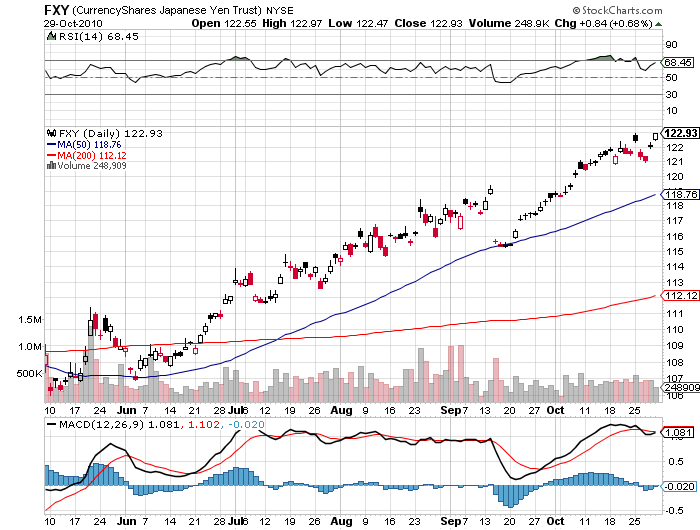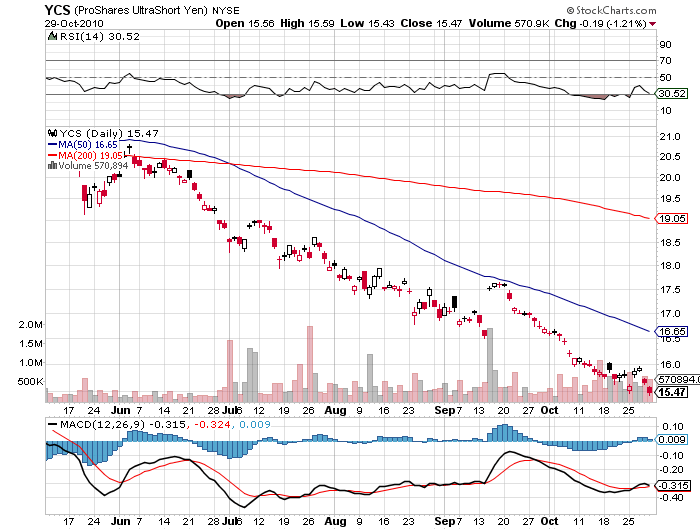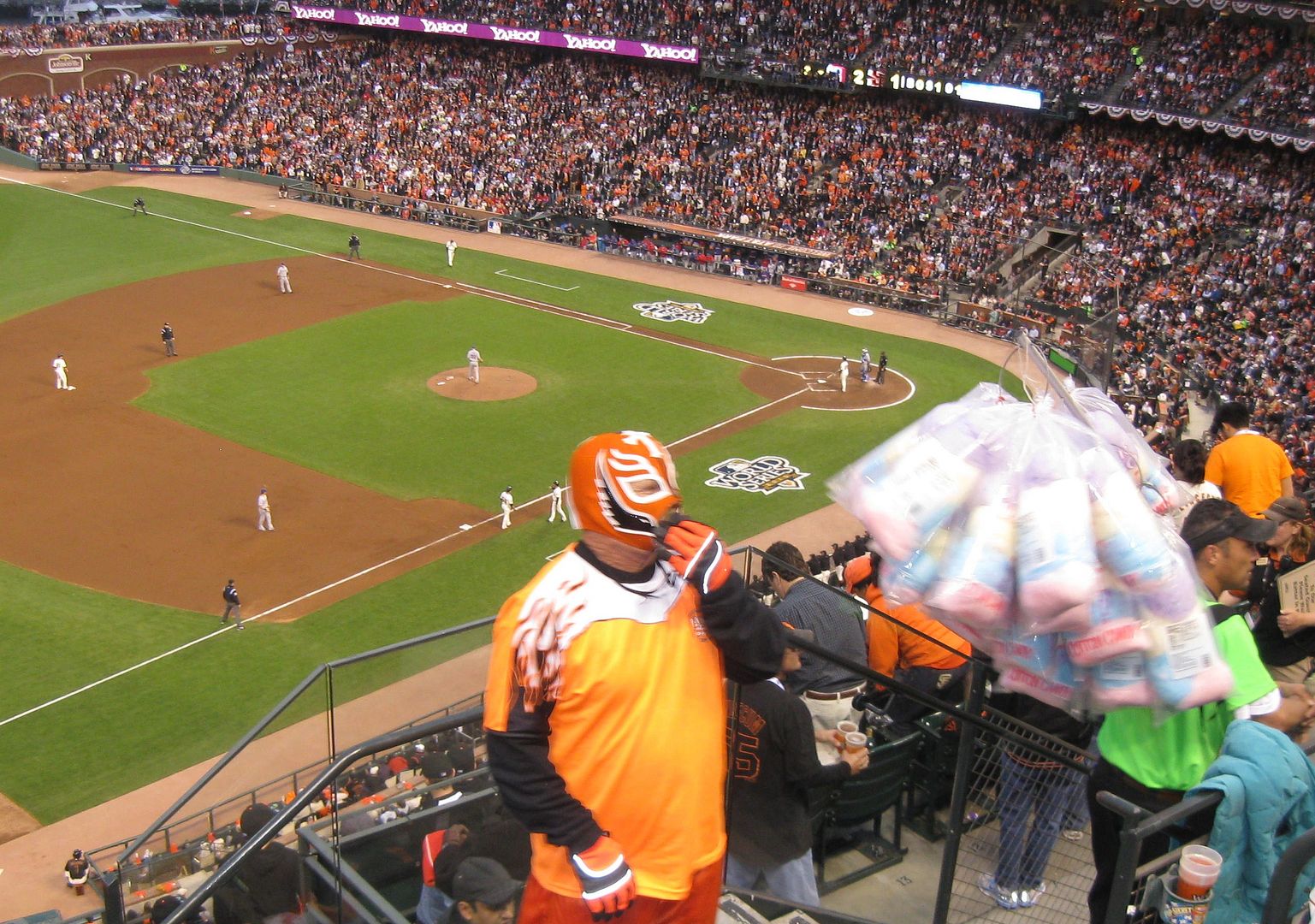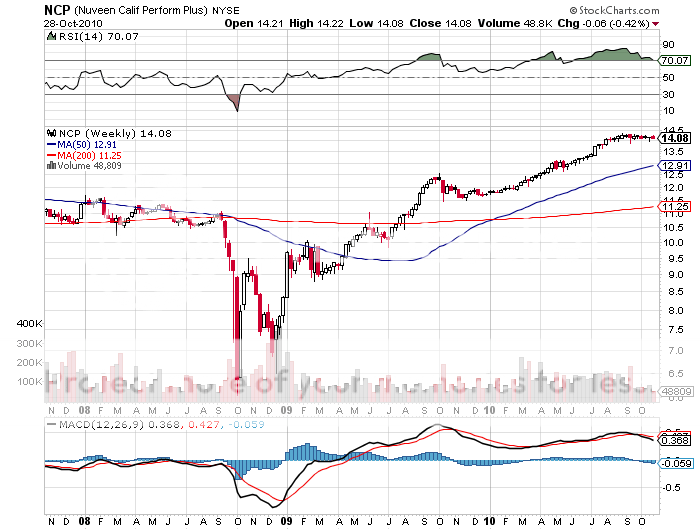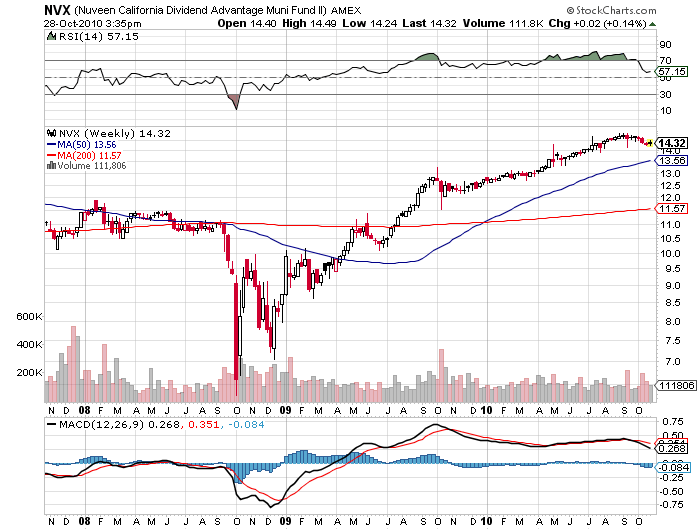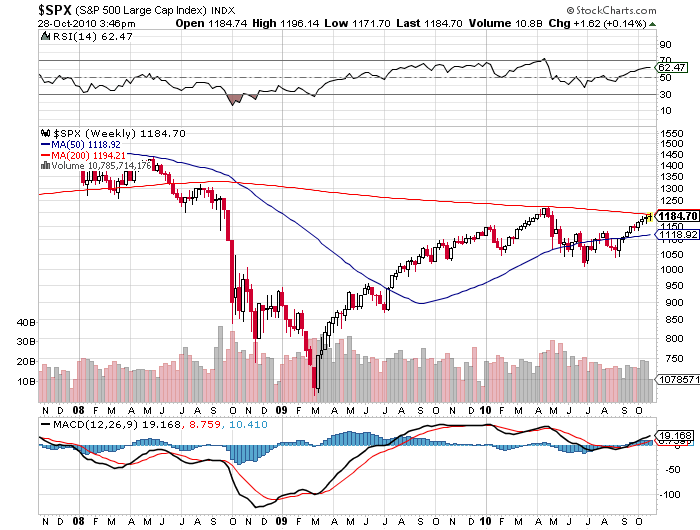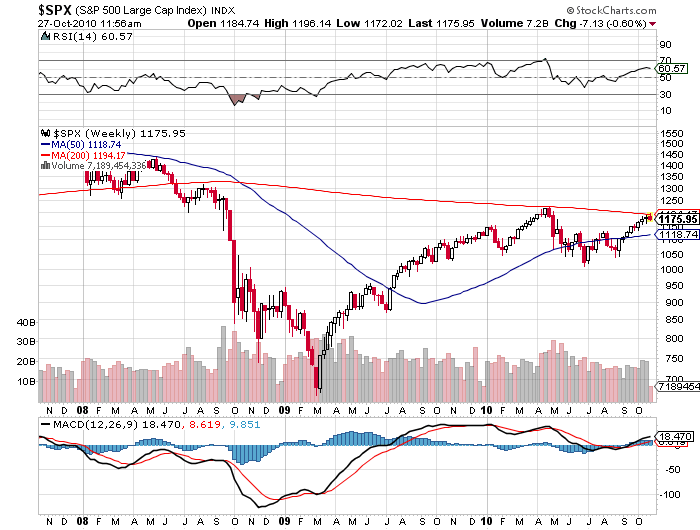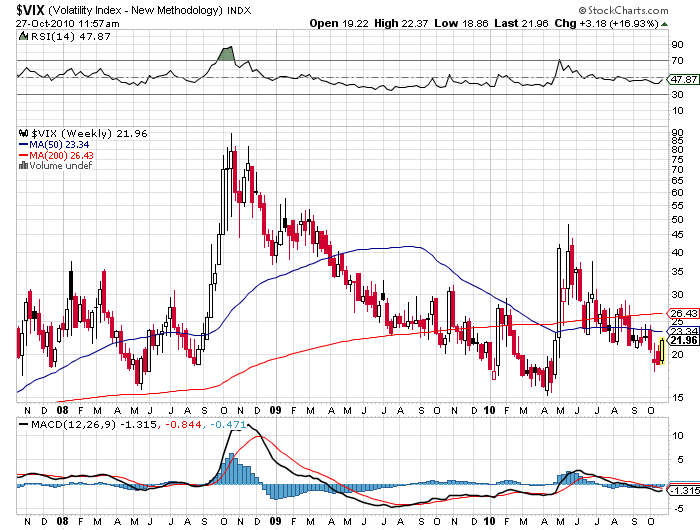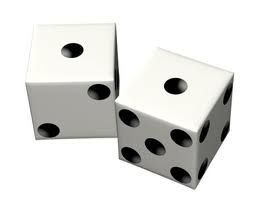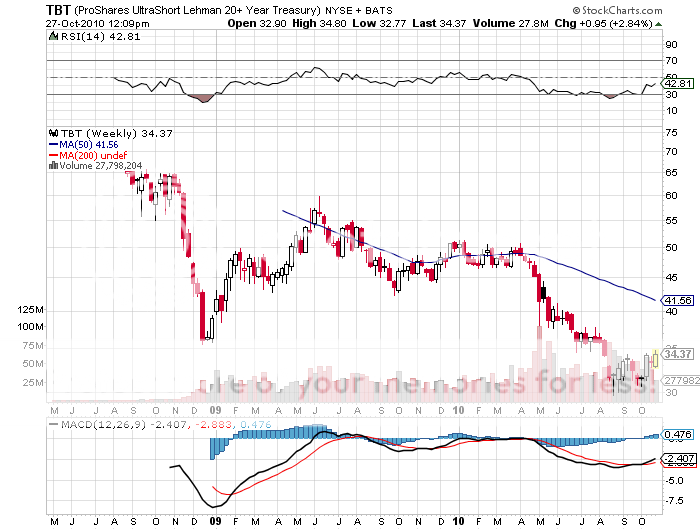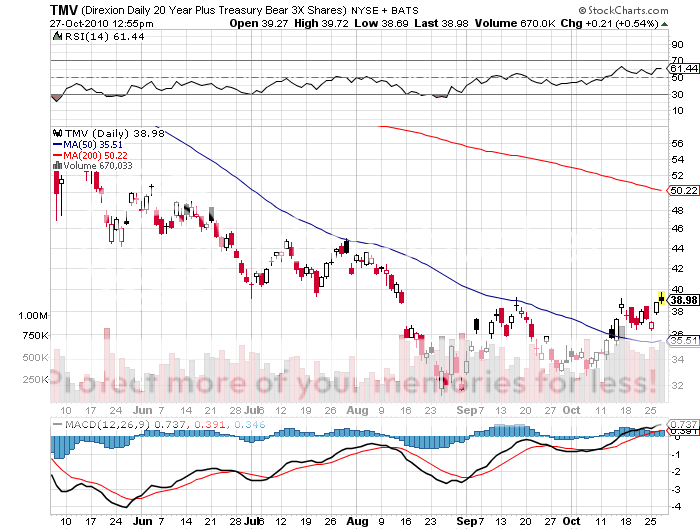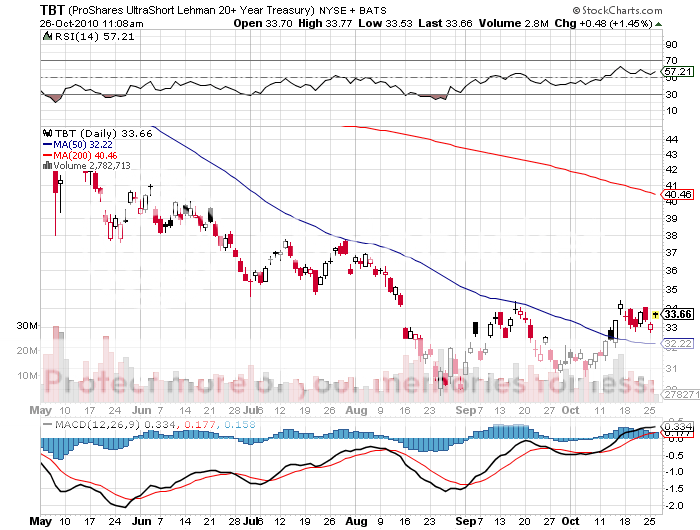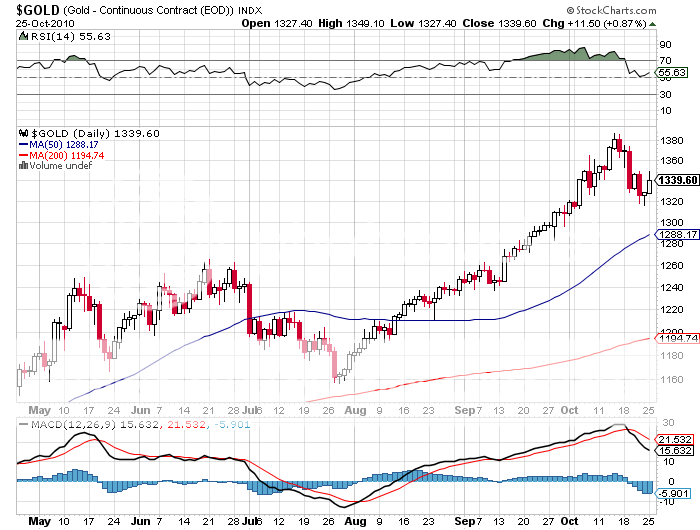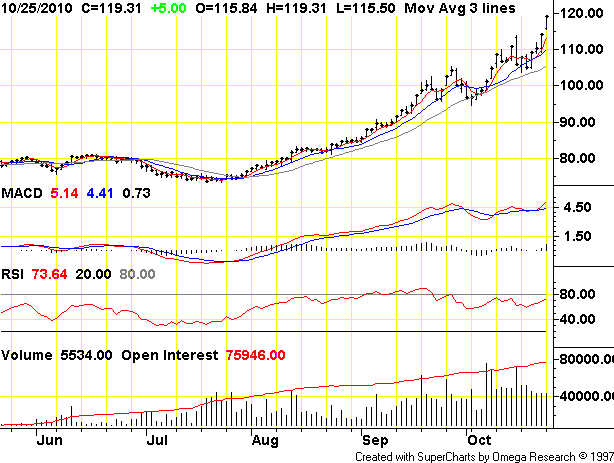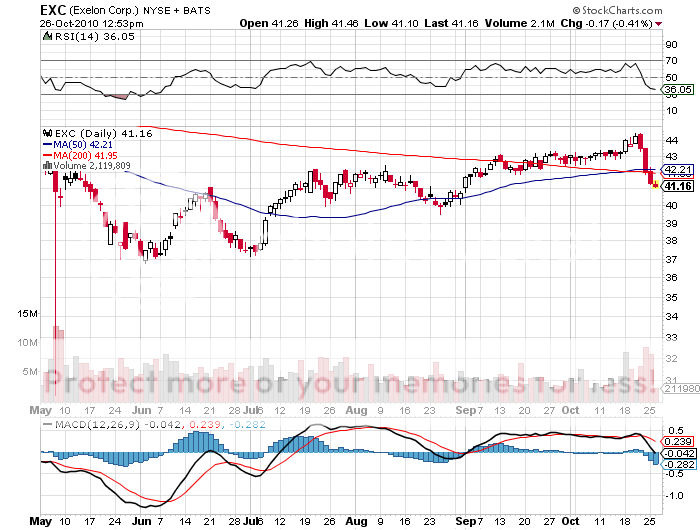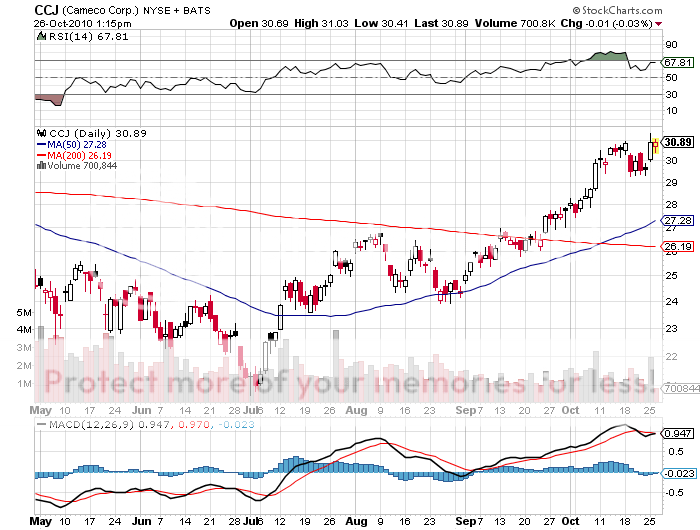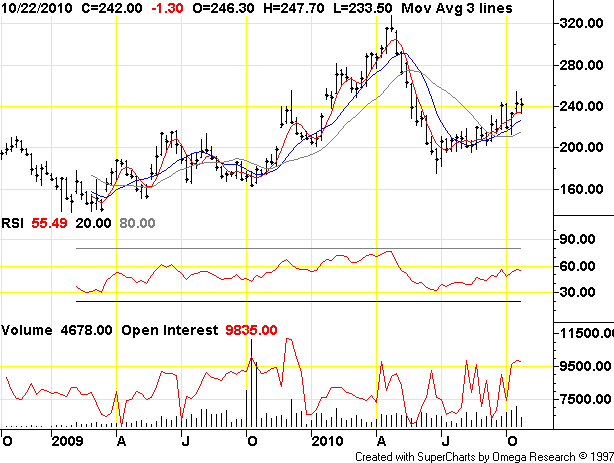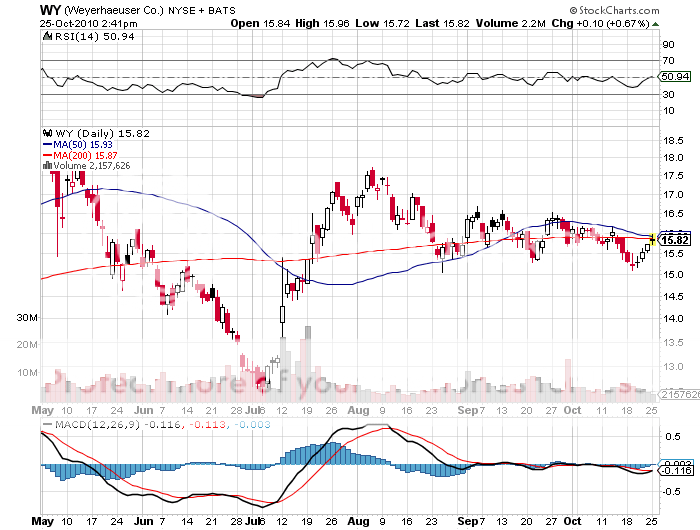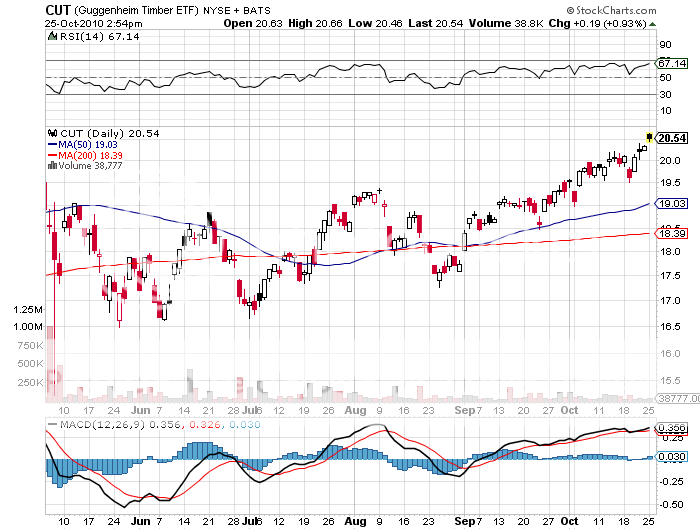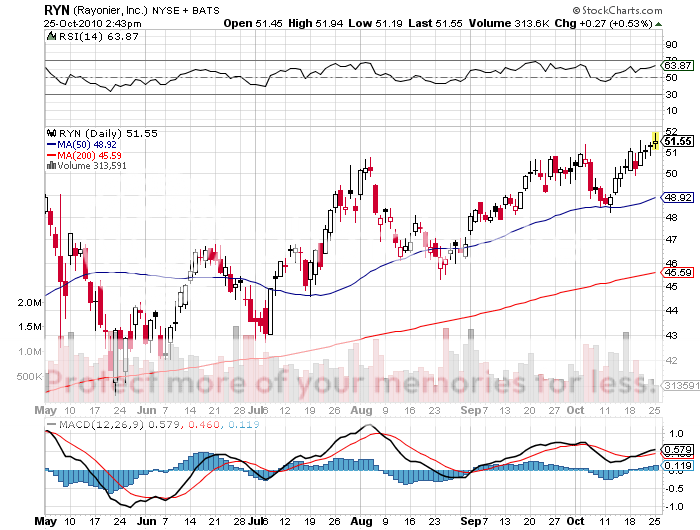
Featured Trades: (JAPANESE YEN), (FXY), (YCS)
3) Pricking the Bubble in the Yen. Analysts have been puzzled by the relentless appreciation of the Japanese yen, which went out at ?80.40 on Friday, and seems poised to break out to the ?70 handle and an all time high. Having written the authoritative tome on the Japanese banking system 30 years ago (it's in the Library of Congress), I can shed more than a little light on why.
Unknown to most in the trading community, foreign banks have engaged in a massive recapitalization of their Japanese subsidiaries since over the last six months. Since May, excess foreign bank reserves held in yen have soared from $246 billion to $562 billion, an increase of a staggering $316 billion, creating immense upward pressure. Some $136 billion of this poured into the yen in September alone. By comparison, there are only $7.3 billion worth of net longs held in futures markets by speculators.
Ask Japanese senior bankers why this is happening, and you get lame excuses, like anticipation of stiffer capital requirements from the Bank of Japan to head off any future financial crisis. The truth is that banks are using their balance sheets to speculate in the currency markets and boost profits. Adding fuel to the fire has been efforts by the People's Bank of China to diversify out of the dollar as a reserve asset by pouring new cash flows into the yen. This is showing up in a huge jump in overnight bill purchases by foreign investors.
In days of old, countries used to destroy their neighbors by sending in invading armies of screaming warriors swinging great long swords. Today, you simply buy their currency; drive it to ridiculous heights, making its industry hopelessly uncompetitive in the global market place, thus collapsing its economy. This is what China is doing to Japan today.
This explains why the central bank's intervention efforts to slow the yen's appreciation have been an abject failure. In September, total BOJ sales of yen amounted to only $61 billion, and has been spread among a range of lower tier assets, like 'BBB' rated corporate bonds, exchange traded funds (ETF's), and REIT's. The Japanese government is slumming with its own version of QEII. But the amounts so far are miniscule compared to the inflows. They might as well be pissing in the ocean.
There are two ways this kabuki play will go end. The obvious one is for the BOJ to boost its intervention to the $1 trillion that worked the last time it was in this pickle eight years ago. I sense that a Pearl Harbor type surprise attack of this sort is setting up. Suck the shorts in with a series of small, ineffective interventions that invite laughter and derision, and then all of a sudden, its tora, tora, tora and bombs away. The shorts get taken to the cleaners.
The second approach will be more subtle. Banks are currently earning 10 basis points on their excess reserves. Turn this number negative, as Germany and Switzerland did, and the banks will bail on their excess reserves in a heartbeat. It's not a matter of if, but when they do this. Then the 15 year double top chartists have been waiting for will be in place, and one of the great shorts of the decade, and the (FXY) and the (YCS) will be in play. This all may happen very fast, so keep you finger poised over that mouse.
Is the Bank of Japan Planning a Surprise Attack on the Yen Shorts?
Why the Bank of Bank of Japan's Intervention Efforts Aren't Working
Featured Trades: (WORLD SERIES)
1) From Your Mad Hedge Fund Trader Baseball Correspondent. What a game! Burp. The San Francisco Giants trounced the Texas Rangers 11-7 in what had to be one of the most exciting games in World Series History.
I spent the pregame completing my Christmas shopping for the year, feverishly buying commemorative baseballs, knit hats, and T-shirts at $40 a pop. China's trade surplus must be soaring. A Niagara Falls of beer was pouring out of the concession stands. The air was electric with enthusiasm.
Tony Bennett sang the Star Spangled Banner. The F-16's flew in formation 500 feet overhead right on cue. Nancy Pelosi and Mayor Gavin Newsome sat just below me, where else, but in the left infield.? In fact, a foul ball almost landed in the lap of the Speaker of the House of Representatives.
Starting Giants pitcher, Tim Lincecum, seemed to defy the laws of physics, using a slight, boyish frame to throw a sizzling 98 mile per hour fast ball. In the fifth inning the Giants were hitting them like they were playing T-ball, scoring six runs. Both teams looked like they had been cleaned out from a home for juvenile delinquents. Are baseball players getting younger, or am I getting older?
I missed heavyweight, Juan 'The Panda' Uribe, belt out a home run because I was stuck in the 30 minute line to get into the men's room. The red clad Texas Rangers cheering section went comatose, where else, but in the upper right field bleachers.
Tony Bennett then sang I Left My Heart in San Francisco during the seventh inning stretch. Both sides threatened to score in every inning. We spent virtually the entire game standing on our feet screaming our lungs out.
Many thanks to the San Francisco Bay Area readers who emailed encouragements to me throughout the game. To the Texas readers who sent messages like 'Yeeeehaaaaaa Texas' when they scored, a pox on your houses, homesteads, teepees, or wherever you live in that God forsaken land.
When Brian Wilson stuck out the last Ranger hitter, the fireworks went off over the bay. The city exploded into celebration, with cars everywhere honking their horns and cable cars ringing bells. Probably 100,000 poured out of packed bars into the streets for a huge nonstop party. Groping my way through the crowd, I almost got run over by the black GM Suburbans of Nancy Pelosi's Secret Service detail.
I almost fell asleep on the last train home. If I had, I would have ended up at the end of the line at Pittsburgh/Bay Point, where I would have gotten mugged and lost all of my $40 T-shirts. But I didn't. I'm back to Earth today writing this letter with the mother of all hangovers.
Yes, We Have Our Own Team Serial Killer
Featured Trades: (MUNICIPAL BONDS), (NCP), (NVX)
Nuveen California Performance Plus
Nuveen California Dividend Advantage Muni Fund II
2) The Fascinating World of Municipal Bonds. I was fortunate to catch the muni bond wave this year with my recommendations to buy the funds in this sector, the (NCP) and the (NVX) (click here for 'California Municipal Bonds Are a Steal'). I turned negative on bonds of every description in August, fearing that the popping of the government bond bubble could take down the rest of the fixed income universe down with it (click here for 'The Great Bond Market Crash of 2010').
However, there may be some circumstances unique to certain individuals where hanging on to you muni bonds may make some sense. Treasury bond investors are not being compensated for their risk at current yields, but muni bond investors are. Ten year tax free munis are now yielding 2.58%, delivering an effective taxable rate of 3.97% for those in the top end 35% tax bracket.
If the Bush tax cuts are not extended, that yield jacks up to 4.27% for top earners. In the 30 year arena, the effective taxable rate is 6.38%, and a very generous 6.87% without the Bush cuts. That's a lot in this zero yield world we live in. And let's face it, taxes are going up a lot, no matter who wins the election, making these bonds even more valuable.
The risk of an outright default on this paper has been vastly overblown by the media. California's $70 billion in general obligation debt, which is used mostly for infrastructure spending, is at the very top of the seniority structure, followed by $150 billion in retirement benefits debt. These claims are untouchable.
All of the budget cuts going forward will take place with the junior claims in the obligation structure, mostly schools and social services. That is why we are seeing rioting at UC Berkeley and demonstrations at welfare offices. And with the stock market up 78% in 20 months, capital gains will start kicking in, which in peak years account for 40% of total state tax revenues.
For those who would rather leave slugging it out in the markets every day to the younger crowd, who despair at figuring out the 'new normal', or who don't want to deal with the harsh reality that 'buy and hold' is dead, this may be a good option. Sure, you almost certainly will have to take some ugly marks down the road. But if you are willing to hold this paper to maturity, it might be worth it.
Don't Let Them Scare You Away from Muni Bonds
Featured Trades: (CONTEMPLATIONS ON RISK)
1) Contemplations on Risk. The S&P 500 has risen 11 out of the last 13 trading days. Everything in my portfolio is up 50% in the last four months, except for the rare earth stocks which are up 400%. My call that the global equity markets would launch into a surprise up move driven by better than expected earnings, sending shorts scrambling, turned out to be one of the best in my career (click here for 'My Equity Scenario for the Rest of 2010'). So far, 82% of reporting companies have surprised to the upside. It doesn't get any better than this.
Now that everything is ridiculously overbought on a short term basis, I have to ask: What can go wrong with this party? When will investors flip from 'RISK ON' to 'RISK OFF' mode? Should I pick up my ball and go home? I'm sorry, but I am one of those guys who believes that the higher prices go, the more risk they carry, and the more volatility they threaten. Most people believe the opposite.
I see three possible near term inflection points setting up for the markets:
I) The November 2 elections. A surprise Democratic win would send the markets into a tailspin. Much of the buying since august has been driven by an expected Republican takeover of the House of Representatives. If that doesn't materialize as promised, the punch bowl would disappear very quickly.
II) Year End. Many hapless financial advisors have bought the top of the market and then sold the bottom for the second year in a row. As a result, 30% of active managers are now underperforming the index. To catch up, they are buying this year's hottest stocks hand over fist, driving markets higher still. This is why you are seeing so much buying concentrated in lead names like Apple (AAPL), which now accounts for an amazing 20% of the NASDAQ. Flip the page on the calendar and all this buying may end.
III) End Q1, 2011. The QEII surge continues for another five months, the S&P 500 challenges this year's high of 1,240, and New Year cash allocations pour into the market. Then Bernanke says 'Ha Ha, fooled you! I'm not doing any QEII because you guys already did it for me!' We then run into a repeat of 2011 where six months of feast are followed by six months of famine. The 'double dip' scenario once again rears its ugly head. This is what lost decades are supposed to look like.
While I am not certain which of these three scenarios plays out, I know for sure what to do when one hits. 'RISK OFF' means the dollar and volatility go up, and stocks, bonds, commodities, currencies, food, and emerging markets go down. Retail participation in the equity markets shrinks to two guys sitting in rocking chairs on a porch in Arkansas waiting for their cable to get installed.
Don't kid yourself into thinking that you can hedge against these losses, or that diversification will protect you. We live in a binary, bipolar world, and the only hedge that truly works is cash.
Featured Trades: (PEAK TREASURY BONDS), (TBT), (TMV)
ProShares Ultra Short Lehman 20 + Year Treasury ETF
Direxion Daily 20 Year Plus Treasury Bear 3X Shares ETF
2) The Fat Lady is Still Singing in the Treasury Market. To say that things have gone well for the Treasury bond market this year would be one of the understatements of the century. First there was a global flight to safety triggered by the European debt crisis. Then there was the mad rush by hedge funds to cover shorts in securities they believed were the world's most overpriced assets. Then Ben Bernanke appeared on the scene with QEII, sending bond prices everywhere to 50 year highs.
Every academic study showing that government paper had 30 years of underperformance ahead of them, including my own, only seemed to drive prices higher (click here for 'A Visit to the Insane Asylum'). In fact, my report on 'The Great Bond Market Crash of 2010' lagged the actual peak in bond prices by just five days (click here for the piece). At the August high, the Treasury market was effectively discounting 0% inflation for ten years, an insanity I was happy to bet against.
The recent action in the markets suggests that the turn may finally be behind us. Why have bond prices been falling for the past month, despite an assumed promise by the Fed to provide unlimited amounts of liquidity? Why has a ton of Chinese and other foreign buyers failed to set a new high. Is it possible that the fat lady is at last singing in the Treasury bond market?
Let's say we get a 'RISK OFF' reversal in global financial markets. The short Treasury Bond ETF (TBT) bottomed at $30 at the end of August and has made it back up to $34.? Take it back to this year's high of $52 and that gives you a 73% gain off the bottom. The 2009 high gets you to $60, an even 100% return. If you don't feel like betting the ranch here and want to approach this in a sober, risk controlled manner, look at the cheap, out-of-the-money March or June, 2011 $45 calls on the (TBT). Get this one right and the profit will be several fold.
Featured Trades: (THE WORLD'S LARGEST SOLAR PLANT)
3) The World's Largest Solar Plant. Unfortunately, I know Blythe, California too well. This natural blast furnace is in a God forsaken corner of the state where I hunted jack rabbits as a kid, the Indians survived on Gila monsters for protein, and it regularly reaches 130 degrees in the shade. It is also where Peter Fonda and Dennis Hopper crossed the 'bridge of no return' over the Colorado River in the cult flick Easy Rider. Blythe has unsurprisingly become ground zero for the global thermal solar movement, which I have been chronicling with great interest in these pages (click here for 'The Solar Boom in California').
The entire industry has just taken a quantum leap forward with the approval of a massive 2.8 megawatt plant to be built by Solar Trust of America, a joint venture between two European companies. It dwarfs the 392 MW plant to be built by BrightSource Energy which only received its own go ahead weeks ago. It is all part of a rush to start alternative energy projects before Federal subsidies from Obama's 2009 stimulus package expire at the end of this year. The Solar Trust project expected to qualify for $900 million in cash grants and additional loan guarantees from the Department of Energy.
The facility will deploy arrayed mirrors over 7,025 acres, or 11 square miles, aimed at a conventional steam turbine. This will generate enough electricity for 2 million homes, about 15% of the total in California. With the Tres Amigas facility in New Mexico coming online soon, this raises the possibility of the Golden State selling excess green, carbon free power to the rest of the West (click here for that piece).
Sorry guys, no equity play here. The new plant will be built and operated by privately held European companies that have been flocking to the US with their advanced technology to cash in on our generous subsidies. But it does make other publicly listed smart grid, transmission, and storage plays out there more interesting. It is all part of a huge, new alternative energy industry that is growing far faster than most investors realize.
Who Knew This Place Would Be Worth Something Someday?
Featured Trades: (THE COMMODITIES BOOM)
1) Here Come the Seventies Again. Better drag your leisure suits, bell bottoms, and Bee Gee's records out of the attic. The seventies are about to enjoy a comeback. The near universal run all commodities are enjoying now takes me back to that time in my youth when making money was as simple as buying an ounce of gold, a barrel of oil, or a bushel of corn. Cotton hit its highest price since the Civil War yesterday, when Union a blockade of the South sent prices skyrocketing (see Gone With the Wind). (Smart Alecs out there please don't bother to ask if I fought in the Civil War. That was my older brother).
QEII is truly lifting all boats, even the leaky ones, like the US stock market. The debasement of the dollar this policy assures will keep money pouring into virtually every tradable asset in the world, including stocks, bonds, currencies, commodities, precious metals, and yes, even real estate. The great thing about QEII is that Ben Bernanke doesn't have to do it, he only needs to think it, or to hint about it, and the private sector will execute it for him. Has anyone noticed that is exactly what's happening now, with all asset prices rising in lockstep globally?
I have a feeling that this love fest is going to end the same way it did in the eighties too. The Fed knows it is creating a monster with the enormous amounts of money it is now creating, and that someday, it will have to drive a giant steak through its heart in the form of huge and cathartic interest rate rises. That will not happen this year, or next. But when it does my prediction that the short Treasury bond ETF, the (TBT) will roar from $30 to $200 could look conservative.
Until then, party away as if you are an extra in John Travolta's Saturday Night Fever. The Japanese have a wonderful expression that applies here which I constantly heard throughout the eighties: 'When the fools are dancing, the greater fools are watching.'
Featured Trades: (NUCLEAR POWER), (EXC), (CCJ)
3) Is Exelon Building an Alternative Energy Conglomerate? Exelon (EXC) popped up on my radar a few months ago, when it bought the wind energy business from John Deere (DE) for $900 million. The company plans to cash in on a national trend by states requiring their power companies to obtain fixed minimum amounts of electricity from green, carbon free alternative sources.
California has the most ambitious goal, setting a 33% target by 2020 (click here for 'The Solar Boom in California').? Some 28 other states are following suit with lesser thresholds, and more are expected to follow. You would think wind is a bad place to invest on the eve of a Republican takeover of the House of Representatives that could herald the freezing or elimination of all alternative energy government subsidies.
In fact, wind energy is now competitive on a non subsidized basis in many parts of the country. That is what Google (GOOG) obviously thinks, since it recently committed to investing $5 billion in a massive offshore grid meant to harvest power from planned wind energy projects off the East coast.
There is another political angle to this story. Exelon already has a large established business maintaining nuclear power plants. The nation's 100 facilities are getting long in the tooth, some approaching 60 years old, and are in desperate need for modernization. Exelon already has contracts to upgrade 39 of these.
While the Republicans' alternative energy credentials leave something to be desired, they are big fans of carbon free nuclear, which I believe will be a crucial part of any long term energy solution. That's why you find top uranium producer Cameco (CCJ) is my model portfolio, which has soared a stunning 55% since August.
To top it all, (EXC) offers a whopping great 5.1% dividend, which effectively makes it a mid rated corporate bond in this low yield world. If you are looking for a low volatility name to add to your portfolio in this sector, Exelon might me a good one.
Getting Long in the Tooth
Featured Trades: (TRADING A 'LOST DECADE')
3) How to Trade a 'Lost Decade.' Having concluded that you should be selling rallies in the US markets, I would add the proviso that you shouldn't sell just yet. Counter trend rallies can last for years, and this time we have QEII on the side of the bulls, which we are only two months into.
Helicopter Ben is also getting an assist from history. The third year of a presidential term is historically the best for the stock market. For the past 100 years, the stock market has risen by an average 13% during the third year of every administration, nearly double the long term historical average. Since 1961, that gain has been a blistering 18%.
This happens because administrations do whatever they can to boost the economy going into elections with voter friendly, tax cutting policies. So, third year GDP growth is high, averaging 4%, versus the long term average of 2.44%. Isn't democracy a wonderful thing? Therefore, don't keep a hair trigger on selling or shorting strategies. Give the markets a chance to breathe. The Dow could make it all the way up to 14,000 and still be in a long term secular downtrend.
I think the US has entered another lost decade, but expect a lot of volatility along the way. If you are wondering why I am sending you so many long term, deep, 'Think' pieces these days, it's because there is nothing to do here. It is too late to buy, but too early to sell. Keep your powder dry, and live to fight another day.
A New Trading Strategy?
Featured Trades: (LUMBER), (WY), (CUT), (RYN)
4) The Monetization of Lumber. If you want to see how widespread the commodities boom has become, take a look at the lumber market, which has popped 47% since June. This is in the face of new home starts that are flat on their back, posting the worst numbers in modern history.
Suffice it to say that the lumber market has changed beyond all recognition. The monetization of lumber is now a big driver, as investors scour the globe for dollar alternatives and hard asset surrogates. China has stepped into the market as a big buyer, as it has everywhere else. You only need to spot some visitors from the People's Republic at a Chinese restaurant in Portland to tack another five cents on to lumber prices.
The strong loonie is pricing supplies from the Frozen Wasteland of the North out of the market. Prices are also getting an assist from the mountain pine beetle, where a long term draught is enabling them to devastate Western forests, cutting into supplies.
The US industry is much less elastic than it has been in the past, as so much capacity has been shut down and scrapped, thanks to the housing crisis. Add the lead lumber equity plays to your 'buy on dips' list of US commodity plays. These include the recently trustified Weyerhaeuser (WY),? the lumber ETF (CUT), and Rayonier (RYN).
Lumber Futures Have Been On Fire


